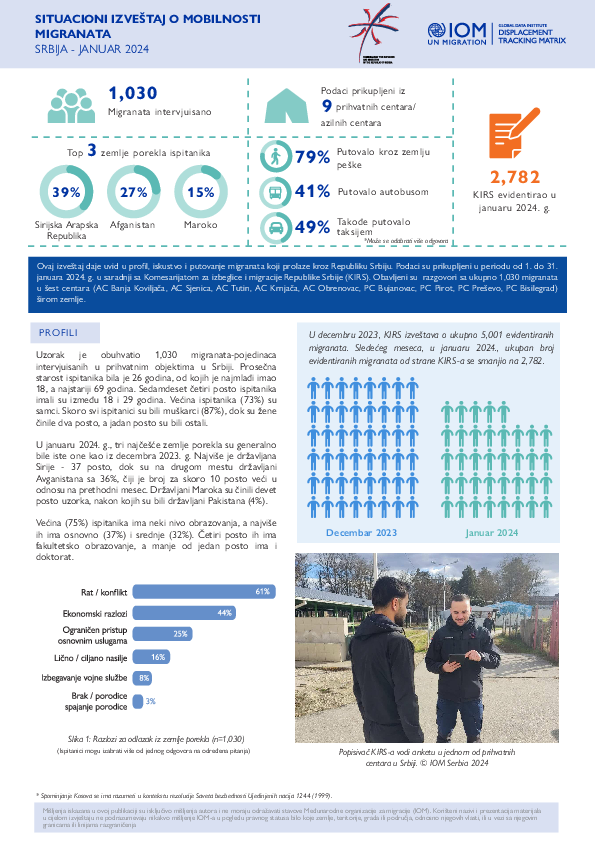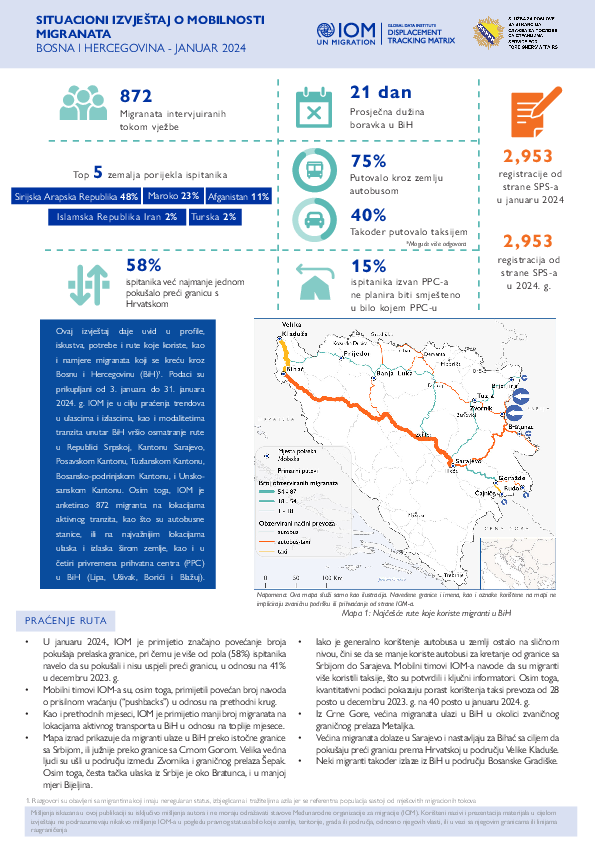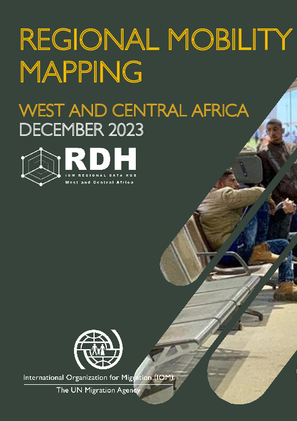-
Countries
-
Data and Analysis
-
Special Focus
-
Crisis Responses
Flow Monitoring
Within the West and Central Africa (WCA) region, the Sahel stretches from Mauritania to Chad, separating the Sahara desert on the North, from tropical coastal countries to the South. Overall, within the African continent, it spans from the Atlantic Ocean on the West to the Red Sea on the East, separating the desert from the savanna. Migratory routes within the WCA region inevitably cross the Sahel and - throughout their journeys - migrants are facing multiple risks along these routes.
This report compiles information from different data and research activities held within the region in the objective to highlight the diverse dynamics, profiles and risks migrants are facing while travelling on the WCA routes through the Sahel. This dashboard covers the period until December 2023 and is based on information from (1) Displacement Tracking Matrix (DTM) data on mobility trends and population flows; (2) Missing Migrants Project (MMP) data on arrivals to Europe and the Canary Islands, migrant deaths and disappearances; (3) Data on migrants seeking Assisted Voluntary Return and Reintegration (AVRR) to and within the WCA region; (4) Expulsions of migrants from other regions to WCA, especially from Algeria and Libya; (5) Transhumance Tracking Tool (TTT) data on the mobility of transhumant populations throughout the Sahel; and (6) Solutions and Mobility Index (SMI) indicators of stability within the Sahelian region.

Contact
DTM Pakistan, DTMPakistan@iom.int
Language
English
Location
Pakistan
Period Covered
Feb 01 2024
Feb 15 2024
Activity
- Flow Monitoring
On 26 September 2023, the Ministry of Interior in Pakistan announced its decision to enact its “Illegal Foreigners’ Repatriation Plan (IFRP)”. Between 1 and 15 February 2024, 7,215 Afghan nationals returned to Afghanistan, including 5,040 through the Torkham BCP, 1,720 through the Chaman BCP, 455 through the Ghulam Khan BCP, while no Afghan nationals returned through the Badini BCP. In addition, border authorities deported 61 individuals due to a lack of valid documentation. Since 1 January 2024, IOM identified 26,734 returns at the four BCPs.
The development and implementation of policies and programmes in West and Central Africa promoting safe, orderly and humane migration require a better understanding of human mobility in the region.
Human mobility in the region take many different forms. Transhumance, seasonal migration conducted during the harvesting season, travel during religious festivities, tourism, economic migration to North Africa and Europe, the search for employment in the mining industry, forced displacements due to conflict, natural disasters or climate-related migration, rural exodus, are all examples of movements observes in West and Central Africa and show the many faceted nature of mobility in the region.
This document is an attempt to provide a dynamic and regularly updated portrait of mobility within, from and to West and Central Africa regionon for Migration (IOM), the United Nations Department of Economic and Social Affairs (UNDESA) and the United Nations High Commissioner for Refugees (UNHCR).
A better understanding of migratory movements in West and Central Africa is critical to support the programmes and decision-making of the International Organization for Migration (IOM). Since 2016, IOM collects data at strategic transit points throughout the region to monitor the various intra and interregional movements and migrations trends.
This document presents key results from interviews conducted with female travellers in 2023 along migration routes in West and Central Africa.

Contact
DTM Iraq, IraqDTM@iom.int
Language
English
Location
Iraq
Period Covered
Sep 01 2023
Nov 30 2023
Activity
- Survey
- Flow Monitoring Survey
- Flow Monitoring
DTM Iraq collects data at border crossing points with neighbouring countries – the Islamic Republic of Iran (Iran), the Syrian Arab Republic (Syria) and the Republic of Türkiye (Türkiye) – to better understand migration movements in the Middle East. Cross-border monitoring is designed to capture and describe migration flows. Data displayed in this report were collected employing two approaches: a headcount of all travellers entering or leaving Iraq and a survey of randomly selected travellers. Data collection took place between 1 September and 30 November 2023. Further details on the survey methodology, selection of respondents and border crossing points are available in the Methodological Overview on the DTM website.
As part of the activity, DTM team continued its effort of collecting data on issues that may signify protection risks and concerns among travellers passing through the monitored border crossing points for reasons relating to labour. This report presents a count of those travelling for reason related to work, as well as their main socio-demographic characteristics, type of employment/job offer pursued and possible indicators of exploitation such as performing work or any activities against their will, work without getting the expected payment or receiving false information about the nature or the location of the work.
This report provides insights into the profiles, experiences, needs, routes travelled and intentions of migrants transiting through the Western Balkans.
IOM surveyed 2,178 migrants2 from 1 January to 31 January 2024 in Albania, Bosnia and Herzegovina, Montenegro, North Macedonia, Serbia and Kosovo*.
* References to Kosovo* shall be understood in the context of UN Security Council Resolution 1244 (1999).

Contact
DTM Iraq, IraqDTM@iom.int
Language
English
Location
Iraq
Period Covered
Sep 01 2023
Nov 30 2023
Activity
- Survey
- Flow Monitoring Survey
- Flow Monitoring
DTM Iraq collects data at border crossing points with neighbouring countries – the Islamic Republic of Iran (Iran), the Syrian Arab Republic (Syria) and the Republic of Türkiye (Türkiye) – to better understand migration movements in the Middle East. Cross-border monitoring is designed to capture and describe migration flows.1 Data displayed in this report were collected employing two approaches: a headcount of all travellers entering or leaving Iraq and a survey of randomly selected travellers. Data collection took place between 1 September and 30 November 2023. Further details on the survey methodology, selection of respondents and border crossing points are available in the Methodological Overview on the DTM website.
Between September and November 2023, Ibrahim al Khalil saw the most traffic with a total of 73,242 travellers and 14,427 vehicles passing through the border crossing point, whilst Fishkhabour saw the least traffic with 22,217 travellers and 1,226 vehicles passing through the border.
Around 7 in 10 of travellers were male, with a significant portion between 18 and 34 years old (47%). A smaller portion were female (31%), with 61 per cent being between 35 and 60 years old, showcasing a contrast with the male demographic, where younger individuals were more prevalent. More than half of all travellers had a secondary education level or a tertiary degree or higher, while only 2 per cent of the travellers reported having no form of education. Only 25 per cent of travellers have a stable income, mostly working in the private sector, while more than half of all travellers have either an unstable income (50%)2 or were unemployed (7%) at the time of the survey. A small proportion of travellers were looking for work or had received a job offer (5% of incoming travellers and 7% of outgoing travellers). Regarding protection risks, 2 per cent of travellers entered Iraq for humanitarian reasons. Among those who received help migrating, 4 per cent of outgoing travellers relied on the services of brokers or smugglers to arrange their travel.

Contact
DTM Europe, DTMMediterranean@iom.int
Language
English
Location
Serbia
Period Covered
Jan 01 2024
Jan 31 2024
Activity
- Survey
- Flow Monitoring
This report provides insights into the profiles, experiences and journeys of migrants transiting through the Republic of Serbia. Data was collected from 1 to 31 January 2024 together with the Commissariat for Refugees and Migrants of the Republic of Serbia (SCRM). Total of 1030 migrants were interviewed in six centres (Asylum Centre (AC) Banja Koviljaca, AC Sjenica, AC Tutin, AC Krnjaca, AC Obrenovac, Reception Centre (RC) Bujanovac, RC Pirot, RC Presevo, RC Bosilegrad) across the country.

Contact
DTM Europe, DTMMediterranean@iom.int
Language
Bosnian, Croatian, Serbian
Location
Serbia
Period Covered
Jan 01 2024
Jan 31 2024
Activity
- Survey
- Flow Monitoring
Ovaj izveštaj daje uvid u profil, iskustvo i putovanje migranata koji prolaze kroz Republiku Srbiju. Podaci su prikupljeni u periodu od 1. do 31. januara 2024. g. u saradnji sa Komesarijatom za izbeglice i migracije Republike Srbije (KIRS). Obavljeni su razgovori sa ukupno 1,030 migranata u šest centara (CA Banja Koviljača, CA Sjenica, CA Tutin, CA Krnjača, CA Obrenovac, PC Bujanovac, PC Pirot, PC Preševo, PC Bisilegrad) širom zemlje.

Contact
DTM Europe, DTMMediterranean@iom.int
Language
Bosnian, Croatian, Serbian
Location
Bosnia & Herzegovina
Period Covered
Jan 01 2024
Jan 31 2024
Activity
- Survey
- Flow Monitoring
Ovaj izvještaj daje uvid u profile, iskustva, potrebe i rute koje koriste, kao i namjere migranata koji se kreću kroz Bosnu i Hercegovinu (BiH)1. Podaci su prikupljani od 3. januara do 31. januara 2024. g. IOM je u cilju praćenja trendova u ulascima i izlascima, kao i modalitetima tranzita unutar BiH vršio osmatranje rute u Republici Srpskoj, Kantonu Sarajevo, Posavskom Kantonu, Tuzlanskom Kantonu, Bosansko-podrinjskom Kantonu, i Unsko-sanskom Kantonu. Osim toga, IOM je anketirao 872 migranta na lokacijama aktivnog tranzita, kao što su autobusne stanice, ili na najvažnijim lokacijama ulaska i izlaska širom zemlje, kao i u četiri privremena prihvatna centra (PPC) u BiH (Lipa, Ušivak, Borići i Blažuj).
Pagination
- Previous page
- Page 25
- Next page



